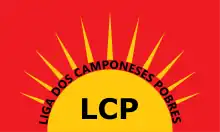League of Poor Peasants
The League of Poor Peasants (Brazilian Portuguese: Liga dos Camponeses Pobres, LCP) is a left-wing farmer organization based in Brazil. The LCP was formed in 1995 in reaction to the Corumbiara Massacre, when landless activists in Rondônia were killed by police and armed mercenaries. Much of the League was drawn from the Landless Workers' Movement (MST) after dissatisfaction with its agrarian reformism.[1]
Liga Dos Camponeses Pobres | |
 | |
| Predecessor | Landless Workers' Movement |
|---|---|
| Formation | 1995 |
| Legal status | Social movement |
| Purpose | Agrarian Revolution |
Region | |
| Methods | Land occupation (squatting), Collectivized farming, Health and educational services, Armed violence (allegedly) |
| Affiliations | Worker League (Liga Operária) Popular Women's Movement (MFP) Brazilian Center of Solidarity with the People (CEBRASPRO) |
The LCP takes a radical approach to the peasant situation, supporting the occupation and transformation of large estates into productive collectives structured under People's Power Assemblies. These assemblies determine both short and long-term planning and development for the collectives, as well as its conduct.[2]
Although not a guerrilla organization, the militancy of the LCP has brought it into much conflict with the Brazilian government, which often coordinates police interventions towards occupied camps and associated activists.[3] The group also has faced death threats and selected assassinations from hired gunmen which the League claims is a collaborated effort between the government and landowners.[4]
Ideology
According to the LCP's publication Nosso Caminho (Our Path), the organization's general program outlines the goals for an agrarian revolution in the Brazilian countryside to replace latifundia with collective production and structure. The general program is defined by 15 points:[5]
- The end of the latifundia; all land to the tillers
- The land with social destination according to interests of the majority of the people and the nation
- Nationalization of land and large rural capitalist enterprises as the final objective
- A new agricultural and credit policy to make small and medium landownership economically viable
- The creation and promotion of agro-villages and industrial application in every rural region
- The creation of a health system with needed infrastructure in the countryside
- The creation of an education system, A School of a New Type, centered on production and class struggle
- Independent social and political organization based on the direct democracy of People's Assemblies
- Special policy for the dry (semi-arid) northeast region
- Special policy for the Amazon region
- Support for the city worker struggle; strengthen the worker/peasant alliance
- Recognition and support for the self-determination of indigenous nations and peoples
- Strengthen and develop the masses' ideology/politics towards land collectivization as a final objective
- A new economy, a new culture, a new politics of new democracy, and a new People's Democratic Power
- Internationalist solidarity with the struggle of peoples against imperialism and for progress
References
- Silva, David Pimentel Oliveira (2013). "A LIGA DOS CAMPONESES POBRES (LCP) E A ESPACIALIZAÇÃO DA LUTA PELA TERRA NO CAMPO ALAGOANO". Revista GeoNordeste (in Portuguese) (3). ISSN 2318-2695.
- Kistler, C. (2020-05-09). "The LCP is laying the Basis for Building New Power in the Countryside of Brazil". Redspark. Retrieved 2023-08-04.
- "Como as milícias rurais dominaram Rondônia e quem é o homem por trás da mais poderosa delas". Brasil de Fato (in Brazilian Portuguese). 2022-11-28. Retrieved 2023-08-04.
- "Brazil land activists facing "increased intimidation" with six killings in 2016". Reuters. 2016-04-29. Retrieved 2023-08-04.
- "Nosso Caminho". www.marxists.org. Retrieved 2023-08-18.